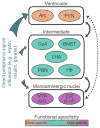Overlapping Brain Circuits for Homeostatic and Hedonic Feeding
- PMID: 29107504
- PMCID: PMC5762260
- DOI: 10.1016/j.cmet.2017.09.021
Overlapping Brain Circuits for Homeostatic and Hedonic Feeding
Abstract
Central regulation of food intake is a key mechanism contributing to energy homeostasis. Many neural circuits that are thought to orchestrate feeding behavior overlap with the brain's reward circuitry both anatomically and functionally. Manipulation of numerous neural pathways can simultaneously influence food intake and reward. Two key systems underlying these processes-those controlling homeostatic and hedonic feeding-are often treated as independent. Homeostatic feeding is necessary for basic metabolic processes and survival, while hedonic feeding is driven by sensory perception or pleasure. Despite this distinction, their functional and anatomical overlap implies considerable interaction that is often overlooked. Here, we argue that the neurocircuits controlling homeostatic feeding and hedonic feeding are not completely dissociable given the current data and urge researchers to assess behaviors extending beyond food intake in investigations of the neural control of feeding.
Keywords: dopamine; hypothalamus; obesity; reward.
Copyright © 2017 Elsevier Inc. All rights reserved.
Figures


References
-
- Aberman JE, Salamone JD. Nucleus accumbens dopamine depletions make rats more sensitive to high ratio requirements but do not impair primary food reinforcement. Neuroscience. 1999;92:545–552. - PubMed
-
- Abrahamsen GC, Berman Y, Carr KD. Curve-shift analysis of self-stimulation in food-restricted rats: relationship between daily meal, plasma corticosterone and reward sensitization. Brain Res. 1995;695:186–194. - PubMed
-
- Alkemade A, Yi CX, Pei L, Harakalova M, Swaab DF, la Fleur SE, Fliers E, Kalsbeek A. AgRP and NPY expression in the human hypothalamic infundibular nucleus correlate with body mass index, whereas changes in alphaMSH are related to type 2 diabetes. J Clin Endocrinol Metab. 2012;97:E925–933. - PubMed
Publication types
MeSH terms
Grants and funding
LinkOut - more resources
Full Text Sources
Other Literature Sources

